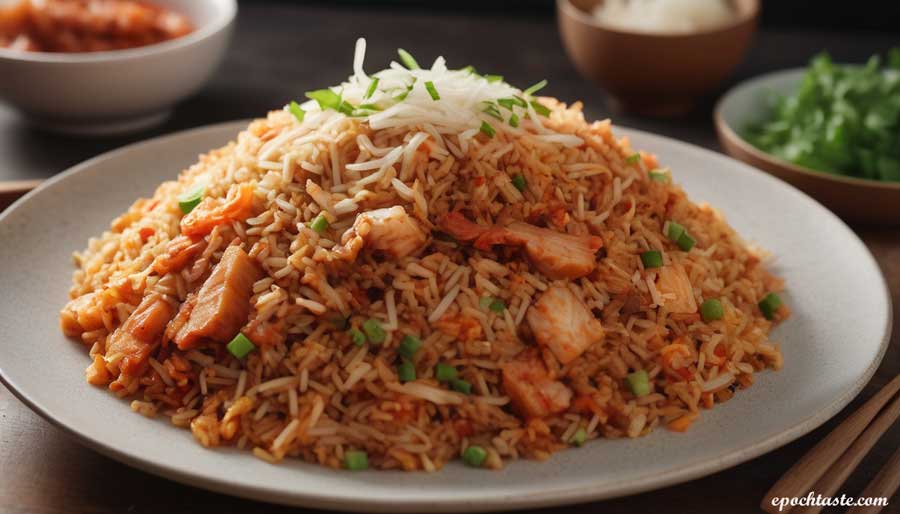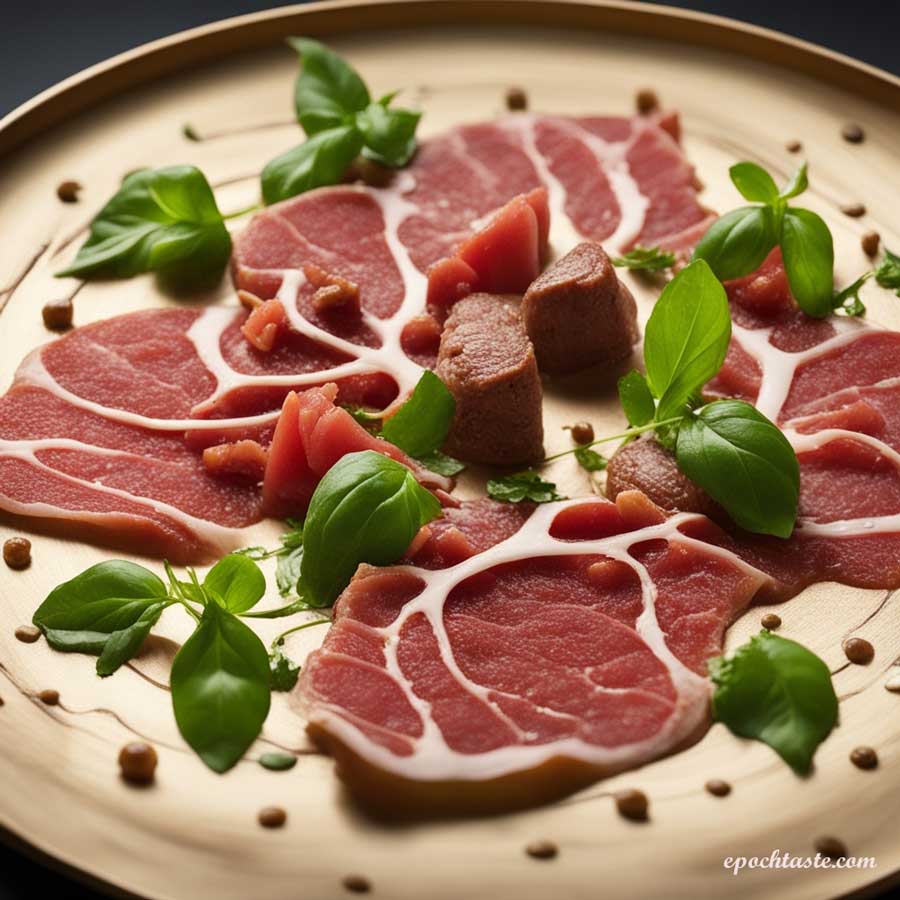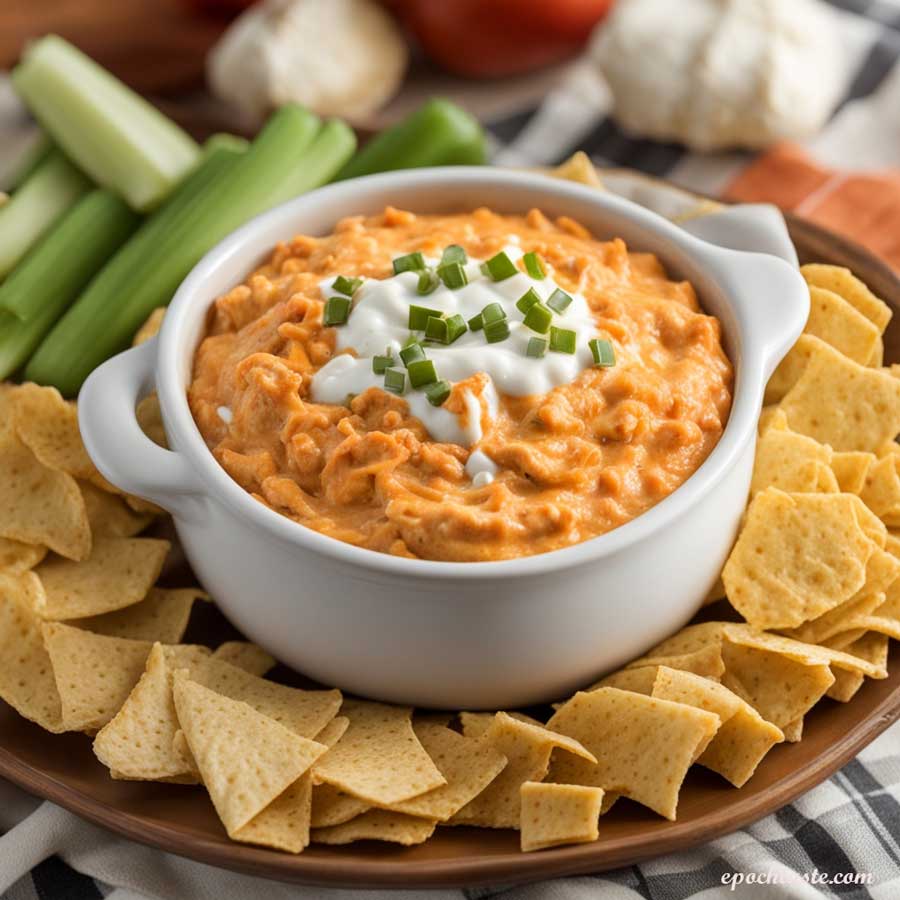- Brief overview of kimchi fried rice and its popularity.
- Mention the keywords subtly for SEO.
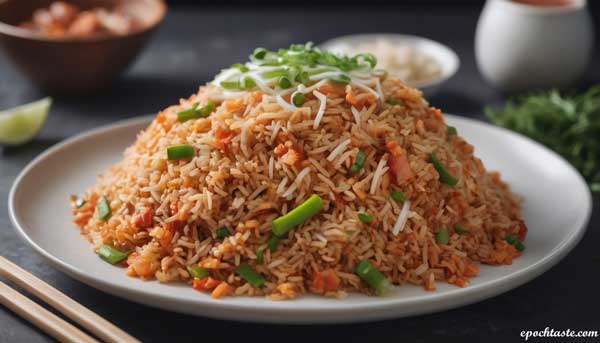
Section 1: What is Kimchi Fried Rice?
Introduction: Kimchi fried rice, known as “Kimchi Bokkeumbap” in Korean, is a delightful fusion dish that combines the bold flavors of fermented kimchi with the comfort of fried rice. This iconic Korean dish has gained international popularity for its savory and spicy profile, making it a favorite among food enthusiasts seeking a quick, flavorful meal.
Origins and Cultural Significance: Kimchi fried rice has its roots in Korean cuisine, where kimchi is a staple. Kimchi, a fermented vegetable dish, is typically made with Napa cabbage and Korean radishes, seasoned with chili pepper, garlic, ginger, and other flavorful ingredients. The dish’s popularity stems from the need to repurpose leftover rice and kimchi, creating a delicious and satisfying meal.
Popularity and Variations: Over the years, kimchi fried rice has evolved into a versatile dish with various interpretations worldwide. Its appeal lies in its simplicity and adaptability. Whether enjoyed as a quick weeknight dinner or served at celebratory gatherings, kimchi fried rice has become a go-to comfort food.
Common Elements: The core ingredients include cooked rice, kimchi, and a flavorful combination of seasonings. Additional ingredients like vegetables, proteins (such as meat or tofu), and sauces contribute to the dish’s richness and complexity. The marriage of these components creates a harmonious blend of textures and tastes.
Why Kimchi Fried Rice? Kimchi’s unique tanginess and spiciness add depth to the fried rice, transforming a basic staple into a gastronomic delight. The dish embodies the principles of Korean cuisine, emphasizing balance and contrast in flavors, textures, and colors.
Adaptability and Fusion: What makes kimchi fried rice truly special is its adaptability. It seamlessly integrates with various cuisines, allowing for creative twists and fusions. From kimchi fried rice burritos to kimchi fried rice sushi rolls, the possibilities are as diverse as the imaginations of those who prepare it.
In the subsequent sections, we will delve deeper into the world of kimchi fried rice, exploring unique recipes, regional variations, and expert tips to master the art of creating this flavorful dish at home.
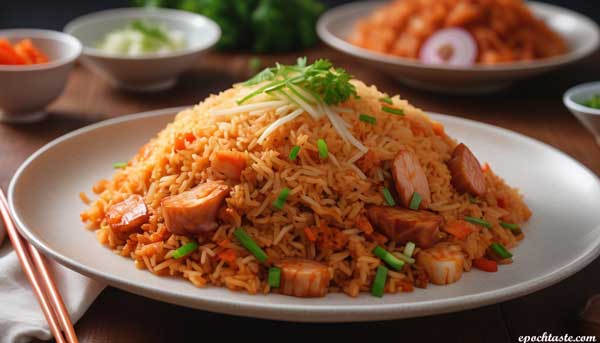
Section 2: Kimchi Fried Rice Recipe with Spam: A Fusion Delight
Introduction: Elevate your kimchi fried rice experience with a surprising and delightful twist – the addition of spam! This fusion dish combines the umami richness of spam with the bold flavors of kimchi, creating a uniquely satisfying culinary experience.
The Role of Spam: Spam, the canned meat product, may seem unconventional, but its savory, salty, and slightly sweet profile adds depth and texture to kimchi fried rice. Its versatility makes it an excellent companion to the robust taste of kimchi, resulting in a dish that balances flavors and satisfies cravings.
Ingredients:
- Cooked rice – preferably day-old for better texture.
- High-quality kimchi – chopped into bite-sized pieces.
- Spam – diced into small cubes.
- Vegetables – commonly used are onions, carrots, and green onions.
- Garlic and ginger – minced for aromatic depth.
- Soy sauce, sesame oil, and a touch of sugar – for seasoning.
- Sesame seeds – for garnish.
Step-by-Step Cooking:
- Heat a pan or wok over medium heat and add a splash of oil.
- Sauté diced spam until golden brown, rendering its rich flavors.
- Add minced garlic and ginger, cooking until fragrant.
- Incorporate chopped vegetables, stir-frying until they’re tender yet still crisp.
- Introduce the star of the show – the kimchi. Cook briefly to infuse its bold flavors.
- Toss in the day-old rice, breaking up any clumps and allowing it to absorb the flavors.
- Drizzle soy sauce and sesame oil over the mixture, stirring well for even distribution.
- For a hint of sweetness, sprinkle a pinch of sugar and continue stirring.
- Finish by adding green onions and sesame seeds for a burst of freshness and crunch.
- Taste and adjust seasonings if necessary.
Tips for Success:
- Use a hot pan to achieve a nice sear on the spam.
- Adjust the quantity of kimchi based on your spice preference.
- Experiment with different vegetables for added color and nutrients.
- Don’t rush – allowing the rice to crisp up slightly enhances the dish’s texture.
Why Spam Works: Spam’s ability to absorb flavors and contribute a satisfying umami kick makes it an ideal partner for kimchi fried rice. The fusion of these two seemingly disparate elements results in a dish that transcends cultural boundaries, creating a harmonious blend of East-meets-West flavors.
In the next section, we’ll explore a variation of kimchi fried rice that caters to those who prefer a milder kick by omitting gochujang, a key ingredient in traditional recipes.
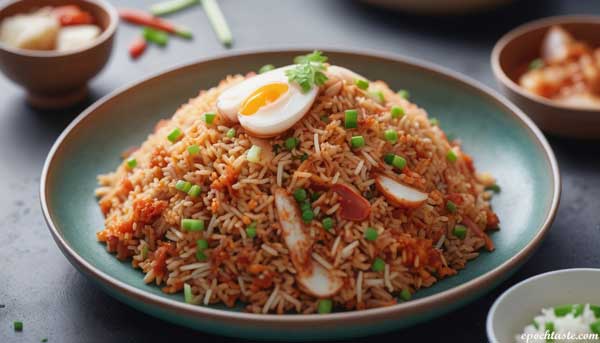
Section 3: Kimchi Fried Rice Without Gochujang: A Mild Twist
Introduction: For those who crave the flavors of kimchi fried rice but prefer a milder spice profile, this variation without gochujang is the perfect choice. By omitting the traditional Korean red pepper paste, we create a version that caters to a wider range of taste preferences while retaining the essence of this beloved dish.
Why Skip Gochujang: Gochujang is a staple in many Korean dishes, adding heat and depth of flavor. However, omitting it allows other ingredients to shine, making this variation suitable for those who prefer a milder taste or have a lower spice tolerance.
Ingredients:
- Cooked rice – day-old rice works best.
- Kimchi – chopped into small pieces.
- Vegetables – commonly onions, carrots, and peas.
- Garlic and ginger – minced for aromatic richness.
- Soy sauce and sesame oil – for seasoning.
- Optional protein – tofu, chicken, or shrimp work well.
- Green onions and sesame seeds – for garnish.
Step-by-Step Cooking:
- Heat oil in a pan or wok over medium heat.
- Sauté garlic and ginger until fragrant.
- Add chopped vegetables and cook until they begin to soften.
- Introduce the kimchi, allowing it to infuse its flavors into the mix.
- If using protein, add it at this stage and cook until fully cooked.
- Incorporate the day-old rice, breaking it up and evenly distributing ingredients.
- Drizzle soy sauce and sesame oil over the mixture, stirring well.
- Continue cooking until the rice is heated through and has a slightly crispy texture.
- Garnish with green onions and sesame seeds.
- Taste and adjust seasonings as needed.
Tips for Success:
- Use a variety of colorful vegetables for both flavor and visual appeal.
- Adjust the quantity of soy sauce and sesame oil to taste.
- Experiment with different proteins for added variety.
Balancing Flavors: The absence of gochujang allows the natural sweetness of vegetables and the tanginess of kimchi to shine through. This milder version of kimchi fried rice appeals to a broader audience, making it an excellent choice for family dinners or gatherings where taste preferences may vary.
In the following sections, we’ll explore unique twists on kimchi fried rice, including a version that incorporates chicken for added protein and flavor.
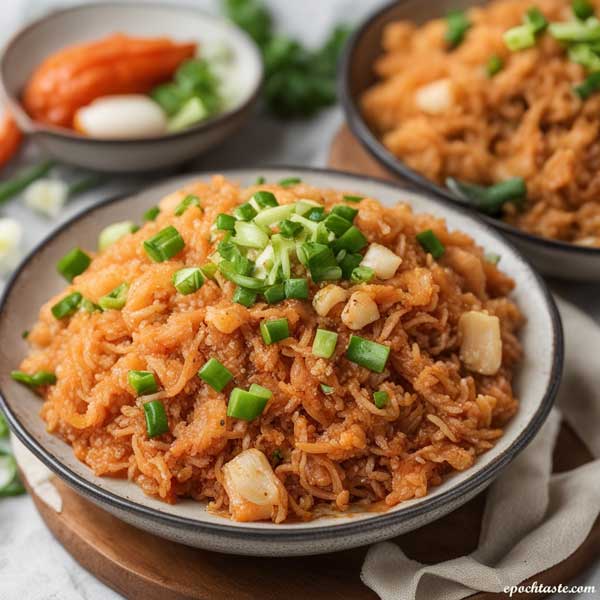
Section 4: Chicken Kimchi Fried Rice: Adding Protein Power
Introduction: Elevate your kimchi fried rice to a heartier level by introducing succulent pieces of chicken. This protein-packed variation not only enhances the dish’s nutritional value but also brings a new dimension of flavor to this beloved Korean fusion classic.
Choosing the Right Chicken: Opt for boneless, skinless chicken thighs or breasts for a quick and easy preparation. The mild flavor of chicken provides a perfect canvas for absorbing the bold tastes of kimchi and other seasonings.
Ingredients:
- Cooked rice – preferably day-old for better texture.
- Kimchi – chopped into bite-sized pieces.
- Boneless, skinless chicken – diced into small cubes.
- Vegetables – onions, carrots, and peas work well.
- Garlic and ginger – minced for aromatic depth.
- Soy sauce, sesame oil, and a touch of sugar – for seasoning.
- Green onions and sesame seeds – for garnish.
Step-by-Step Cooking:
- Heat oil in a pan or wok over medium-high heat.
- Add diced chicken and cook until browned and fully cooked.
- Remove the chicken and set it aside.
- In the same pan, sauté garlic and ginger until fragrant.
- Add vegetables and cook until they begin to soften.
- Incorporate the chopped kimchi, allowing it to infuse its bold flavors.
- Reintroduce the cooked chicken to the pan.
- Add the day-old rice, breaking up any clumps.
- Drizzle soy sauce and sesame oil over the mixture, stirring well for even distribution.
- Sprinkle in a pinch of sugar for a hint of sweetness.
- Garnish with green onions and sesame seeds.
- Taste and adjust seasonings as needed.
Tips for Success:
- Ensure the chicken is cooked thoroughly before reintroducing it to the pan.
- Experiment with different vegetables to add color and nutritional variety.
- Adjust the level of spice by controlling the amount of kimchi used.
Flavor Dynamics: The addition of chicken not only boosts the protein content but also imparts a savory richness to the dish. The tender, juicy chicken complements the spicy kick of kimchi, creating a well-balanced and satisfying meal that’s perfect for lunch or dinner.
As we continue our exploration of kimchi fried rice, the next section will delve into the essential ingredients that form the foundation of this flavorful dish.
Section 5: Kimchi Fried Rice Ingredients: Unveiling the Essentials
Introduction: At the heart of every great kimchi fried rice dish are its essential ingredients. From the staple base of cooked rice to the flavorful additions of kimchi, vegetables, and seasonings, understanding the role of each component is key to mastering the art of this Korean fusion classic.
1. Cooked Rice: The foundation of kimchi fried rice, the choice of rice can significantly impact the dish’s texture. Day-old rice is preferred as it tends to be drier, preventing the final dish from becoming mushy. The grains should be separate, allowing them to absorb the flavors without becoming sticky.
2. Kimchi: The star of the show, kimchi, is a fermented vegetable dish that brings a unique tanginess and spiciness to the fried rice. While Napa cabbage kimchi is traditional, variations with radishes or other vegetables offer distinct flavor profiles. Chop the kimchi into bite-sized pieces for even distribution throughout the dish.
3. Vegetables: Commonly used vegetables include onions, carrots, and peas. These add both color and texture to the dish. Experiment with other vegetables like bell peppers or mushrooms for added variety. Ensure the vegetables are cut into uniform sizes for even cooking.
4. Garlic and Ginger: Minced garlic and ginger contribute aromatic richness to kimchi fried rice. Sautéing them at the beginning of the cooking process enhances their flavors and infuses the entire dish with a subtle depth.
5. Soy Sauce and Sesame Oil: Soy sauce provides saltiness and depth of flavor, while sesame oil adds a nutty aroma. These two ingredients work in harmony to season the dish. Start with small amounts and adjust to taste, keeping in mind that the saltiness of soy sauce can vary.
6. Optional Protein: To make your kimchi fried rice a complete meal, consider adding protein. Options include diced chicken, shrimp, tofu, or even spam. The protein element adds both texture and substance to the dish, making it more satisfying.
7. Sugar: A touch of sugar balances the flavors in kimchi fried rice, providing a hint of sweetness to counteract the spiciness of the kimchi. Use it sparingly, adjusting to your preference for sweetness.
8. Garnishes – Green Onions and Sesame Seeds: Fresh green onions add a burst of color and a mild, oniony flavor, while sesame seeds contribute a delightful crunch. Sprinkle these on top just before serving for a visually appealing and texturally interesting finish.
Experimentation and Adaptation: The beauty of kimchi fried rice lies in its adaptability. Feel free to experiment with ingredient quantities and variations to suit your taste preferences. Whether you stick to the classics or get creative with your choices, these ingredients form the canvas for your culinary masterpiece.
In the upcoming sections, we’ll explore specific aspects of kimchi fried rice, including the best overall recipe and its traditional preparation in Korean cuisine.
Section 6: Perfecting the Art: Best Kimchi Fried Rice Recipe
Introduction: Perfecting the art of kimchi fried rice requires a thoughtful combination of ingredients, technique, and flavor balance. This recipe encapsulates the essence of this beloved dish, delivering a harmonious blend of textures and tastes that will make it a staple in your culinary repertoire.
Ingredients:
- Cooked Rice: Use day-old rice for optimal texture.
- Kimchi: High-quality, well-fermented kimchi for maximum flavor.
- Vegetables: Onions, carrots, and peas – finely chopped for uniformity.
- Garlic and Ginger: Freshly minced for aromatic depth.
- Protein: Optional but recommended; choose from diced chicken, shrimp, tofu, or spam.
- Soy Sauce and Sesame Oil: Balancing the savory and nutty flavors.
- Sugar: A touch for subtle sweetness.
- Garnishes: Green onions and sesame seeds for a finishing touch.
Step-by-Step Cooking:
- Prepare Ingredients: Have all ingredients chopped and ready for quick assembly.
- Sauté Aromatics: In a hot pan, sauté minced garlic and ginger until fragrant.
- Cook Protein: If using, add and cook the protein until fully cooked. Remove and set aside.
- Vegetable Medley: In the same pan, stir-fry onions, carrots, and peas until slightly softened.
- Kimchi Magic: Introduce the star ingredient – kimchi. Cook briefly to release its bold flavors.
- Rice Integration: Add the day-old rice, breaking up any clumps and ensuring even distribution.
- Season to Perfection: Drizzle soy sauce and sesame oil over the mixture. Sprinkle a pinch of sugar. Stir well.
- Reintroduce Protein: If set aside, add the cooked protein back to the pan. Stir to combine.
- Final Touch: Garnish with chopped green onions and sprinkle sesame seeds for a burst of freshness and crunch.
- Taste and Adjust: Sample the dish and adjust seasonings if needed.
Tips for Perfection:
- Texture Matters: Allow the rice to crisp slightly for a delightful texture contrast.
- Balance Flavors: Taste as you go, adjusting soy sauce, sesame oil, and sugar to achieve the perfect balance.
- Protein Selection: Choose a protein that complements the dish, adding depth without overpowering the kimchi.
Why This Recipe Works: This recipe embodies the essence of kimchi fried rice, with the savory umami from the kimchi, the nuttiness of sesame oil, and the subtle sweetness from a touch of sugar. The optional protein adds a satisfying element, making it a complete and fulfilling meal.
In the following sections, we’ll delve into the traditional Korean preparation of kimchi fried rice and explore its regional variations, showcasing the dish’s versatility across different culinary landscapes.
Section 7: Kimchi Fried Rice in Korean: Embracing Authenticity
Introduction: In delving into the heart of Korean cuisine, the preparation of Kimchi Fried Rice, or “Kimchi Bokkeumbap,” unveils a cultural narrative. This authentic rendition showcases the reverence Koreans hold for the art of transforming simple ingredients into a flavorful and comforting dish.
Ingredients in Korean Kimchi Fried Rice:
- 밥 (Bap) – Cooked Rice: The cornerstone, symbolizing sustenance and tradition.
- 김치 (Kimchi): A culinary emblem, fermented Napa cabbage or radish kimchi is finely chopped.
- 야채 (Yachae) – Vegetables: 양파 (Yangpa) – onions, 당근 (Danggeun) – carrots, and 감자 (Gamja) – potatoes, meticulously selected for depth.
- 닭고기 (Dalk Gogi) – Chicken: Diced, embodying the protein-rich legacy of Korean cuisine.
- 마늘 (Maneul) and 생강 (Saenggang) – Garlic and Ginger: Aromatic essentials, infusing the dish with ancestral warmth.
- 간장 (Ganjang) and 참기름 (Chamgireum) – Soy Sauce and Sesame Oil: The rhythmic dance of flavors, binding the elements together.
- 설탕 (Seoltang) – Sugar: A subtle note, harmonizing the symphony of tastes.
- 대파 (Daepa) – Green Onions: Graceful embellishments, symbolizing the earth’s bounty.
- 깨 (Ggae) – Sesame Seeds: Sprinkles of history, echoing the traditions of Korean culinary artistry.
Authentic Preparation:
- 고기 볶기 (Gogi Bokgi) – Cooking the Meat: A dance of sizzling echoes as diced chicken embraces the heat, setting the stage.
- 야채 볶기 (Yachae Bokgi) – Sautéing Vegetables: The aroma of onions, carrots, and potatoes wafting through, promising a symphony of colors and textures.
- 마늘과 생강 추가 (Maneul-gwa Saenggang Chuga) – Adding Garlic and Ginger: A fragrant interlude, weaving tales of ancient spice routes.
- 김치 넣기 (Kimchi Neolgi) – Adding Kimchi: The entrance of finely chopped kimchi, a bold proclamation of Korea’s fermented legacy.
- 밥 추가 (Bap Chuga) – Adding Rice: A canvas of day-old rice, absorbing the collective essence, ready to narrate its own story.
- 간장, 참기름, 설탕 넣기 (Ganjang, Chamgireum, Seoltang Neolgi) – Seasoning with Soy Sauce, Sesame Oil, and Sugar: The measured pour of soy sauce and sesame oil, the delicate dance with sugar, orchestrating a perfect balance.
- 고기 다시 넣기 (Gogi Dashi Neolgi) – Reintroducing Chicken: The return of cooked chicken, a reunion symbolizing the cohesion of flavors.
- 대파와 깨 추가 (Daepa-wa Ggae Neolgi) – Adding Green Onions and Sesame Seeds: Green onions and sesame seeds, a crescendo of freshness and crunch, elevating the dish to its zenith.
- 맛 조절 (Mat Jojeol) – Taste and Adjust: A final act, ensuring the harmony is flawless, echoing the precision of Korean culinary heritage.
Significance of Korean Kimchi Fried Rice: Beyond sustenance, Kimchi Fried Rice in Korea represents the narrative of resilience, resourcefulness, and a profound connection to the land. Passed down through generations, it encapsulates the spirit of Korean homes, where a humble meal transforms into a cultural expression.
In embracing the authenticity of Kimchi Fried Rice in Korean, we embark on a culinary pilgrimage, discovering the soul of a nation woven into each grain of rice. As our exploration continues, the subsequent section will unravel regional variations, illustrating the dish’s ability to adapt and flourish across diverse culinary landscapes.
Section 8: Kimchi Fried Rice Near Me: Exploring Local Flavors
Introduction: Embarking on a journey beyond traditional borders, the search for “Kimchi Fried Rice near me” unveils a tapestry of local flavors, each reflecting the unique culinary nuances of different regions. From food trucks to family-owned eateries, the dish transforms, adapting to diverse palates while maintaining its core identity.
Finding Kimchi Fried Rice Locally:
- Local Eateries: Explore neighborhood restaurants, cafes, or bistros known for embracing international cuisines. Local chefs often infuse their own creativity into this Korean classic, delivering a delightful surprise for your taste buds.
- Food Trucks and Street Vendors: Street food culture often brings about inventive renditions of traditional dishes. Check out local food trucks or street vendors specializing in global flavors; you might stumble upon a delicious and innovative take on kimchi fried rice.
- Ethnic Fusion Restaurants: Seek out eateries that celebrate fusion cuisine, blending elements from various culinary traditions. These establishments may offer a unique twist on kimchi fried rice, incorporating local ingredients to create a fusion masterpiece.
- Online Platforms: Explore food delivery apps or online review platforms to discover hidden gems in your locality. User reviews and ratings can provide insights into the local favorites, guiding your quest for the perfect plate of kimchi fried rice.
Regional Variations Near Me:
- Asian Fusion Spots: Restaurants blending Asian cuisines might offer a diverse array of kimchi fried rice styles, infusing elements from Chinese, Japanese, or Thai culinary traditions.
- Latin Fusion Eateries: Latin American-inspired kimchi fried rice can be a delightful discovery, where traditional flavors meld seamlessly with the boldness of kimchi.
- Southern Comfort Twist: In certain regions, you might encounter a Southern twist to kimchi fried rice, perhaps with added spices, unique grains, or local meats.
- Mediterranean Fusion: Explore eateries with a Mediterranean influence, where the tanginess of kimchi marries the richness of olive oil, feta, or other regional ingredients.
Connecting Cultures Through Kimchi Fried Rice: Kimchi fried rice, as it travels across diverse kitchens, becomes a bridge between cultures. Each local variation tells a story of culinary exploration, where the universal love for comforting and flavorful food takes center stage.
Supporting Local Businesses: In your quest for the best “Kimchi Fried Rice near me,” remember that each local eatery contributes to the vibrant tapestry of your community. Supporting these businesses not only satisfies your culinary curiosity but also fosters a connection with the diverse flavors that surround you.
Exploring “Kimchi Fried Rice near me” is an adventure in discovering the creativity and adaptability of this beloved dish. As you venture into local eateries, relish the fusion of flavors that transforms a traditional Korean dish into a global culinary phenomenon.
Conclusion: Bringing It All Together
- Recap of key points.
- Encouraging readers to try different variations.
- Inviting feedback and sharing experiences.
Note: Remember to use enticing and informative subheadings, add images for visual appeal, and sprinkle relevant keywords naturally throughout the text for better SEO.

